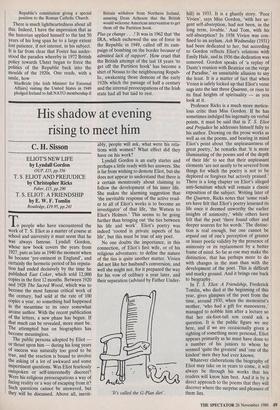His shadow at evening rising to meet him
C. H. Sisson ELIOT'S NEW LIFE by Lyndall Gordon
OUP, f15, pp.356
T. S. ELIOT AND PREJUDICE by Christopher Ricks
Faber, f15, pp.290
T. S. ELIOT: A FRIENDSHIP by E. W. F. Tomlin
Routledge, f19.95, pp.241
To people who have encountered the work of T. S. Eliot as a matter of course at school and university it must seem that he was always famous. Lyndall Gordon, whose new book covers the years from 1927, puts as late as 1940 the moment when he became 'pre-eminent in England', and certainly the hermetic period of his reputa- tion had ended decisively by the time he published East Coker, which sold 12,000 copies in the first 12 months. Between 1920 and 1928 The Sacred Wood, which was to become the most famous critical work of the century, had sold at the rate of 100 copies a year, so something had happened in the meantime to its once somewhat arcane author. With the recent publication of the letters, a new phase has begun. If that much can be revealed, more must be. The attempted ban on biographies has become meaningless.
The public persona adopted by Eliot or thrust upon him — during his long years of success was naturally too good to be true, and the reaction is bound to involve the asking of a lot of awkward and some Impertinent questions. Was Eliot fearlessly outspoken or self-interestedly discreet? Were his religious preoccupations a way of facing reality or a way of escaping from it? Such questions cannot be answered, but they will be discussed. Above all, inevit- ably, people will ask, what were his rela- tions with women? What effect did they have on his work?
Lyndall Gordon is an early starter and perhaps a little ready with her answers. She is far from wishing to demote Eliot, but she does not appear to understand that there is a certain monstrosity about claiming to follow the development of his inner life. She makes the alarming suggestion that `the inevitable response of the active read- er to all of Eliot's works is to become an investigator' of that life, 'the Watson to Eliot's Holmes.' This seems to be going further than bringing out 'the ties between his life and work'. Eliot's poetry was indeed 'rooted in private aspects of his life', but this must be true of any poet.
No one doubts the importance, in this connection, of Eliot's first wife, or of his religious adventures: to define the nature of the ties is quite another matter. Vivien did not like her husband's conversion, and well she might not, for it prepared the way for his vow of celibacy a year later, and their separation (advised by Father Under- `It's called the G-Plan diet'. hill) in 1933. It is a ghastly story. 'Poor Vivien', says Miss Gordon, 'with her ur- gent self-absorption, had not been, in the long term, lovable.' And Tom, with his self-absorption? In 1938 Vivien was con- fined to an asylum. Ash Wednesday (1931) had been dedicated to her, but according to Gordon reflects Eliot's relations with Emily Hale, and in 1936 the dedication was removed. Gordon speaks of 'a replay of Dante's reunion with Beatrice on the verge of Paradise,' an unsuitable allusion to say the least. It is a matter of fact that when Vivien is safely locked up that Eliot's verse sags into the last three Quartets, or rises to its final heights of spirituality — as you look at it.
Professor Ricks is a much more meticu- lous critic than Miss Gordon. If he has sometimes indulged his ingenuity on verbal points, it must be said that in T. S. Eliot and Prejudice he addresses himself fully to his author. Drawing on the prose works as well as on the poems, and bearing in mind Eliot's point about 'the unpleasantness of great poetry,' he remarks that 'it is more illuminating of the poems and of the depth of their life' to see that their unpleasant elements 'are not neatly to be severed from things for which the poetry is not to be deplored or forgiven but actively praised.' There is a long chapter on Eliot's alleged anti-Semitism which will remain a classic exposition of the subject. Writing later of the Quartets, Ricks notes that 'some read- ers have felt that Eliot's poetry lessened its life once it deemed unworthy the earlier insights of animosity,' while others have felt that the poet 'there found other and deeper sources for his words.' The distinc- tion is real enough, but one cannot be argued out of one's perception of greater or lesser poetic validity by the presence of animosity or its replacement by a better frame of mind. So far as one may make the distinction, that has perhaps more to do with changes in the man than with the development of the poet. This is difficult and murky ground. And it brings one back to biography.
In T. S. Eliot: A Friendship, Frederick Tomlin, who died at the beginning of this year, gives glimpses of the poet from the time, around 1930, when the memoirist's mother, `who had a gift for manoeuvre,' managed to nobble him after a lecture so that her six-foot-tall son could ask a question. It is the public figure we see here, and if we are occasionally given a sighting of something more personal, Eliot appears primarily as he must have done to a number of his juniors to whom he seemed 'quite the greatest' and 'one of the kindest' men they had ever known.
Whatever elaborations the biography of Eliot may take on in years to come, it will always be through his works that his readers will know him best. And it is by a direct approach to the poems that they will discover where the surprise and pleasure of them lies.










































































 Previous page
Previous page